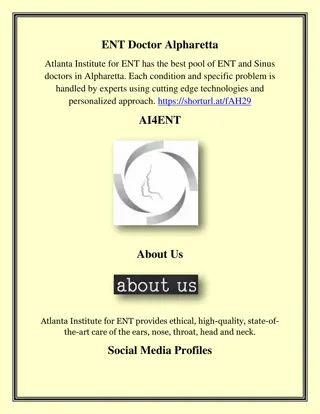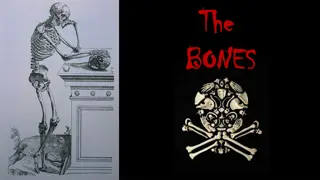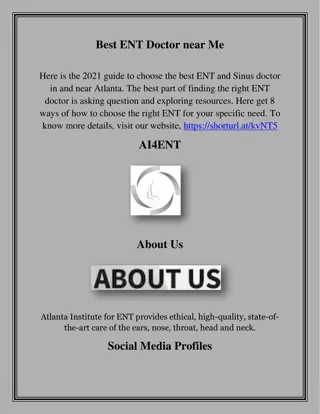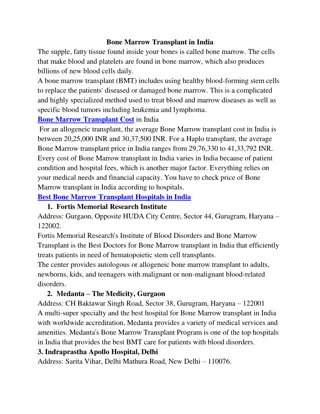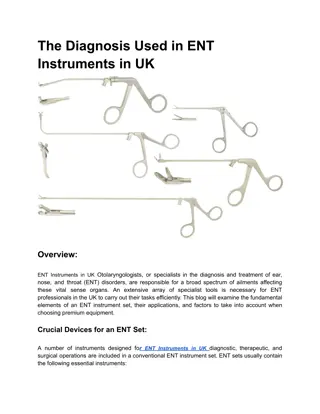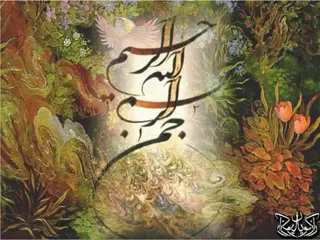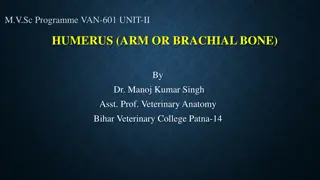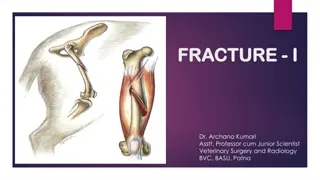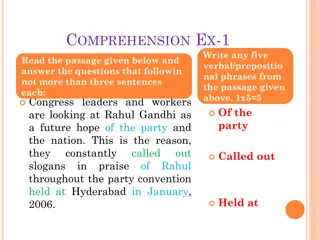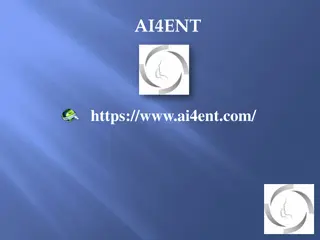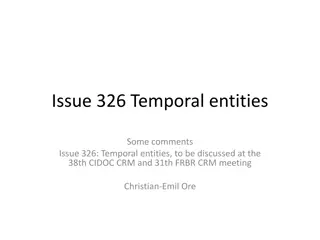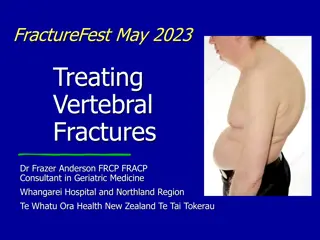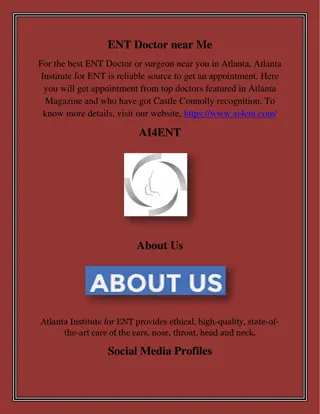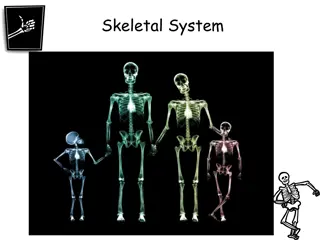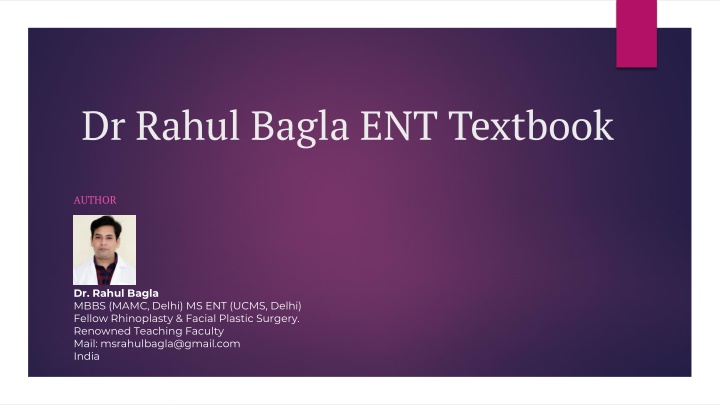
Anatomy of Temporal Bone: Dr. Rahul Bagla's Insights
Explore the intricate details of human temporal bone anatomy as explained by Dr. Rahul Bagla, a renowned authority in the field. Learn about the structure, relations, and parts of the temporal bone, including the squamous part and its crucial connections to surrounding bones. Enhance your knowledge of this essential component of the skull that houses vital structures for hearing and balance.
Download Presentation

Please find below an Image/Link to download the presentation.
The content on the website is provided AS IS for your information and personal use only. It may not be sold, licensed, or shared on other websites without obtaining consent from the author. If you encounter any issues during the download, it is possible that the publisher has removed the file from their server.
You are allowed to download the files provided on this website for personal or commercial use, subject to the condition that they are used lawfully. All files are the property of their respective owners.
The content on the website is provided AS IS for your information and personal use only. It may not be sold, licensed, or shared on other websites without obtaining consent from the author.
E N D
Presentation Transcript
Dr Rahul Bagla ENT Textbook AUTHOR Dr. Rahul Bagla MBBS (MAMC, Delhi) MS ENT (UCMS, Delhi) Fellow Rhinoplasty & Facial Plastic Surgery. Renowned Teaching Faculty Mail: msrahulbagla@gmail.com India
Anatomy of Temporal Bone AUTHOR DR RAHUL BAGLA
Anatomy of Temporal Bone The temporal bone is a paired, symmetrical bone forming the lower lateral walls of the skull. It houses critical structures of the vestibulocochlear apparatus, including the external auditory canal (EAC), middle ear, and inner ear, which are essential for hearing and balance. Additionally, it contributes to the middle cranial fossa, posterior cranial fossa, and skull base.
Anatomy of Temporal Bone Relations of the Temporal Bone: Anteriorly: Greater wing of the sphenoid bone Posteriorly: Occipital bone Medially: Sphenoid bone Inferiorly: Articulates with the mandible, forming the TM joint
Parts of the Temporal Bone The temporal bone is a composite structure consisting of five parts, each ossifying independently and later fuses with each other. Squamous - largest part 1. Petrous - houses inner ear 2. Mastoid - contains air cells 3. Tympanic - forms EAC 4. Styloid - muscle attachments 5. Lateral view Medial view
Squamous part of the Temporal Bone It is the largest and superior most part of the temporal bone. It forms the lateral wall of the middle cranial fossa. It is a thin, translucent, shell-like plate of bone.
Squamous part of the Temporal Bone Relations: Anteriorly: Greater wing of the sphenoid bone and articulates with the zygomatic bone, forming the zygomatic arch Posteriorly: Mastoid part of temporal bone Superiorly: Parietal bone Inferiorly: Forms the roof and minor parts of the EAC walls (the tympanic part of temporal bone forms the rest of the EAC).
Squamous part of the Temporal Bone The squamous part of the temporal bone consists of two surfaces, two borders, a zygomatic process, and a mandibular fossa. The lateral surface is convex, forming the temporal fossa, and houses the origin of the temporalis muscle. It is limited by the supramastoid crest and has a groove for the middle temporal artery. The medial surface is related to the temporal lobe of the brain, with anterior and posterior branches of the middle meningeal artery running over it.
Squamous part of the Temporal Bone The superior border articulates with the inferior border of the parietal bone. The anteroinferior border articulates with the greater wing of the sphenoid bone. The zygomatic process articulates with the temporal process of the zygomatic bone to form a zygomatic arch (palpable as cheekbones ). The mandibular fossa accommodates the temporomandibular joint.
Petrous Part (Rock-like) of Temporal Bone It is located in the base of the skull between the greater wing of the sphenoid bone anteriorly and the occipital bone posteriorly. It separates the middle cranial fossa from the posterior cranial fossa. It also forms a part of the cranial floor. It houses the middle ear, internal ear and mastoid antrum, which it safely shields due to its high bone density. It is a pyramid-shaped structure, having a Base and an Apex Three surfaces (anterior, posterior, inferior) i. ii. iii. Three borders (superior, anterior, posterior)
Petrous Part (Rock-like) of Temporal Bone Apex: It is directed anteromedially toward the greater wing of sphenoid. It contains Meckel s cave (trigeminal nerve) and Dorello s canal (abducens nerve). Infection syndrome (retroorbital pain, diplopia, ear discharge). at the petrous apex can cause Gradenigo s The apex forms the posterolateral margin of foramen lacerum and contains the internal opening of the carotid canal. Base: It fuses with the medial surfaces of the squamous and mastoid parts of the temporal bone.
Petrous Part (Rock-like) of Temporal Bone Anterior Surface (Posterior wall of Middle Cranial Fossa): It presents four important structures (medial to lateral) as follows: Trigeminal impression (lodges trigeminal ganglion) Roof of internal acoustic meatus (depressed area, just lateral to the trigeminal impression) Arcuate eminence (elevated area, formed by the underlying superior semicircular canal) Roof of the middle ear (tegmen tympani) It also presents two openings, the canal for tensor tympani (upper one) and the opening of the bony part of the eustachian tube (lower one).
Petrous Part (Rock-like) of Temporal Bone Posterior Surface (Anterior wall of the Posterior Cranial Fossa): It contains the internal acoustic meatus (IAM) which is 1 cm in length and it is aligned with the external auditory canal. Medial opening of IAM (porus) - The vestibulocochlear nerve, facial nerve and labyrinthine artery enter and pass through it. Lateral opening of IAM (fundus) - The meatus is divided into upper and lower compartments by a bony plate, the horizontalcrest . Upper compartment: Facial nerve passes from anterior aspect while superior vestibular nerve passes from posterior aspect. Lower compartment: Cochlear nerve passes from anterior aspect while vestibular nerve passes from posterior aspect. On the most posterior aspect, there is foramen singular which transmits the nerve to the posterior semicircular canal.
Petrous Part (Rock-like) of Temporal Bone Inferior Surface (Quadrangular area viewed in the Skull Base): It is located between the occipital bone posteriorly and greater wing of sphenoid & squamous part anteriorly. Inferior surface presents: Outer opening of the carotid canal (internal carotid artery). Jugular fossa lies lateral to the carotid canal. Stylomastoid foramen through which facial nerve exit from the middle ear.
Petrous Part (Rock-like) of Temporal Bone Borders of the Petrous Part: Superior border It is a long sharp crest present between middle and posterior cranial fossae. It provide attachment to tentorium cerebelli and it encloses the superior petrosal sinus. Anterior border It can be divided into two parts. Medial part articulates with greater wing of sphenoid while the lateral part joins with the squamous part of temporal bone with a suture petrosquamosal suture. Posterior border It presents groove which lodges the inferior petrosal sinus. Its lateral part creates the superolateral boundary of the jugular foramen.
Mastoid Part of Temporal Bone It is situated posterior to the squamous part of temporal bone. It contains the mastoid antrum and air cells (communicate with the middle ear) It is formed by squamous part (laterally) and a petrous part (medially) separated by Korner s (petrosquamous) septum. Asterion: Meeting point of temporal, parietal, and occipital bones
Mastoid Part of Temporal Bone It has two surfaces (lateral & medial) and two borders (superior & posterior): Lateral surface Itis continuous with mastoid process which provide attachment of SCM, splenius capitis and longissimus capitis muscles. Mastoid process is present just posterior to the external auditory canal opening and it is not fully developed in children. Medial or inner surface Itforms the sigmoid sulcus which lodges sigmoid sinus. Medial surface is further continuous with posterior surface of petrous part of temporal bone. It presents a Digastric notch for attachment to the posterior belly of digastric muscle, Groove for occipital artery which lies medial to digastric notch and Mastoid foramen which is passed by the mastoid emissary vein and artery. Superior border: Articulates with the parietal bone forming parietomastoid suture. Posterior border: Articulates with the occipital bone forming occipitomastoid suture.
Tympanic Part of Temporal Bone Itis a triangular bony plate, situated lateral to the petrous part, inferiorly to the squamous part, and anteriorly to the mastoid part. It is attached to squamous part and mastoid part forming the tympanosquamous anteriorly and tympanomastoid sutures posteriorly.
Tympanic Part of Temporal Bone It has three borders (superior, inferior & lateral) and two surfaces (anterior & posterior): Superior border - It is related to the mandibular fossa Inferior border - It is related to the styloid process Lateral border - along with the posterior surface of tympanic part, it forms anterior, posterior, wall, floor of the bony EAC and ends at the cartilaginous EAC. Anterior surface It is related to parotid gland & mandibular fossa. Posterior surface - tympanicus) for the attachment of the tympanic membrane. It bears a circular groove tympanic sulcus (annulus
Styloid Part of Temporal Bone Styloid process is a long, slender, pointed piece of bone originating from the inferior aspect of the fusion of the tympanic and petrous bones and located in front of the jugular fossa. Its normal length is approximately 2.5 cm. It projects downwards, forwards and medially, giving attachment to several muscles and ligaments. Ligaments Stylohyoid, stylomandibular o Muscles Styloglossus, stylohyoid, stylopharyngeus. o
Styloid Part of Temporal Bone Styloglossus is supplied by hypoglossal nerve, stylohyoid is supplied by facial nerve, stylopharyngeus is supplied by glossopharangeal nerve. Stylomandibular ligament extends from anterior surface of apex of styloid process to the posterior surface of the angle of mandible. This ligament separates submandibular gland & medial pterygoid muscle. parotid gland from The stylomastoid foramen is a round opening situated between the styloid and the mastoid processes. It transmits the facial nerve (CN VII) and the stylomastoid artery

